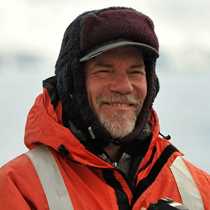At Sea, Drake Passage
Ice defines Antarctica. Remove the ice and the continent would be a very different place, geographically and in essence. The peninsula would reveal itself as a chain of islands. Submerged mountain ranges whose highest summits now barely emerge would rise thousands of feet above surrounding plains. In a reality that mirrors this imaginary change, every winter Antarctica seems to double its area as the seas freeze and vast sheets of pack ice fringe the continent. Long-term residents of this frozen wilderness call it, simply, "The Ice".
Pages, chapters, entire books have been written about the ice of the Antarctic. Glaciers, bergs, blue, white, spindrift, icefalls, brash, seracs, slush, floes, there is an entire lexicon, a culture of ice, which is necessary to any description or discussion of the Southern Continent.
Ice fills the air, covers the sea, bends the light, allows travel, impedes travel; it overwhelms our senses. We come to know ice in a new way as we walk over it, watch it form and melt away, discover it in unexpected places, love it and hate it.
Ice is everywhere around us as we travel in the Antarctic but still some ice is rare. In low sunset light glacier walls glow green. On the calmest, coldest days grease ice smears the surface of the sea, refracting rainbows like oil on a puddle in the city. When deep, super-chilled seawater nears the surface it can form anchor ice, strange sculptures locked to the rocks of the sea floor.
Common, precious, beautiful, deadly. Elemental.
Ice defines Antarctica. Remove the ice and the continent would be a very different place, geographically and in essence. The peninsula would reveal itself as a chain of islands. Submerged mountain ranges whose highest summits now barely emerge would rise thousands of feet above surrounding plains. In a reality that mirrors this imaginary change, every winter Antarctica seems to double its area as the seas freeze and vast sheets of pack ice fringe the continent. Long-term residents of this frozen wilderness call it, simply, "The Ice".
Pages, chapters, entire books have been written about the ice of the Antarctic. Glaciers, bergs, blue, white, spindrift, icefalls, brash, seracs, slush, floes, there is an entire lexicon, a culture of ice, which is necessary to any description or discussion of the Southern Continent.
Ice fills the air, covers the sea, bends the light, allows travel, impedes travel; it overwhelms our senses. We come to know ice in a new way as we walk over it, watch it form and melt away, discover it in unexpected places, love it and hate it.
Ice is everywhere around us as we travel in the Antarctic but still some ice is rare. In low sunset light glacier walls glow green. On the calmest, coldest days grease ice smears the surface of the sea, refracting rainbows like oil on a puddle in the city. When deep, super-chilled seawater nears the surface it can form anchor ice, strange sculptures locked to the rocks of the sea floor.
Common, precious, beautiful, deadly. Elemental.




